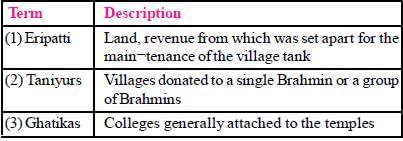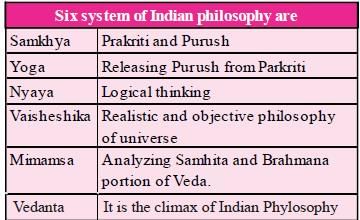Test: Ancient History - 1 - UPSC MCQ
20 Questions MCQ Test UPSC Topic Wise Previous Year Questions - Test: Ancient History - 1
Building 'Kalyaana Mandapas' was a notable feature in the temple construction in the kingdom of
[2019]
With reference to forced labour (Vishti) in India during the Gupta period, which one of the following statements is correct?
[2019]
Consider the following :
1. Deification of the Buddha
2. Treading the path of Bodhisattvas
3. Image worship and rituals
Which of the above is/ are the feature/ features of Mahayana Buddhism?
[2019]
1. Deification of the Buddha
2. Treading the path of Bodhisattvas
3. Image worship and rituals
Which of the above is/ are the feature/ features of Mahayana Buddhism?
In which of the following relief sculpture inscriptions is 'Ranyo Ashoka' (King Ashoka) mentioned along with the stone portrait of Ashoka?
[2019]
Which one of the following is not a Harappan Site?
[2019]
Consider the following pairs of Tradition vs State:
1. Chapchar Kut festival: Mizoram
2. Khongjom Parba ballad: Manipur
3. Thang-Ta dance: Sikkim
Which of the pairs given above is/are correct?
[2018]
Consider the following pairs Craft vs Heritage of:
1. Puthukkuli shawls: Tamil Nadu
2. Sujni embroidery: Maharashtra
3. Uppada Jamdani saris: Karnataka
Which of the pairs given above is/are correct?
[2018]
With reference to Indian history, who among the following is a future Buddha, yet to come to save the world?
[2018]
With reference to the religious practices in India, the "Sthanakvasi" sect belongs to(Pre18 Set-D)
[2018]
Which one of the following was a very important seaport in the Kakatiya kingdom?
[2017]
With reference to the difference between the culture of Rigvedic Aryans and Indus Valley people, which of the following statements is/are correct?
1. Rigvedic Aryans used the coat of mail and helmet in warfare whereas the people of Indus Valley Civilization did not leave any evidence of using them.
2. Rigvedic Aryans knew gold, silver and copper whereas Indus Valley people knew only copper and iron.
3. Rigvedic Aryans had domesticated the horse whereas there is no evidence of Indus Valley people having been aware of this animal.
Select the correct answer using the code given below:
[2017]
Which of the following is/are famous for Sun temples?
1. Arasavalli
2. Amarakantak
3. Omkareshwar
Select the correct answer using the code given below:
[2017]
The painting of Bodhisattva Padmapani is one of the most famous and oft-illustrated paintings at
[2017]
With reference to the religious history of India, consider the following statements:
1. Sautrantika and Sammitiya were the sects of Jainism.
2. Sarvastivadin held that the constituents of phenomena were not wholly momentary, but existed forever in a latent form.
Which of the statements given above is/are correct?
[2017]
In the context of the history of India, consider the following pairs:

Which of the pairs given above is/are correctly matched?
[2016]
Which one of the following books of ancient India has the love story of the son of the founder of Sunga dynasty?
[2016]
With reference to the art and archaeo-logical history of India, which one among the following was made earliest?
[2015]
Which of the following Kingdoms were associated with the life of the Buddha?
1. Avanti
2. Gandhara
3. Kosala
4. Magadha
Select the correct answer using the code given below.
[2014]
The national motto of India, ‘Satyameva Jayate’ inscribed below the Emblem of India is taken from
[2014]
Which one of the following pairs does not form part of the six systems of Indian Philosophy?
[2014]
|
78 docs|31 tests
|



















